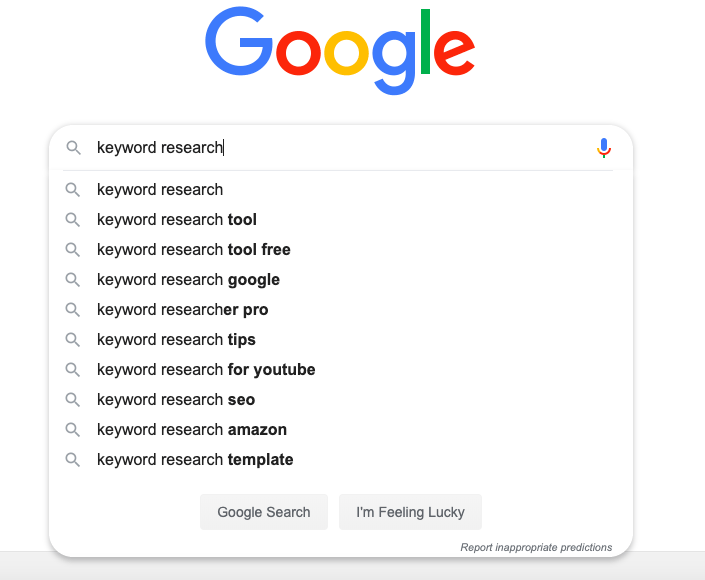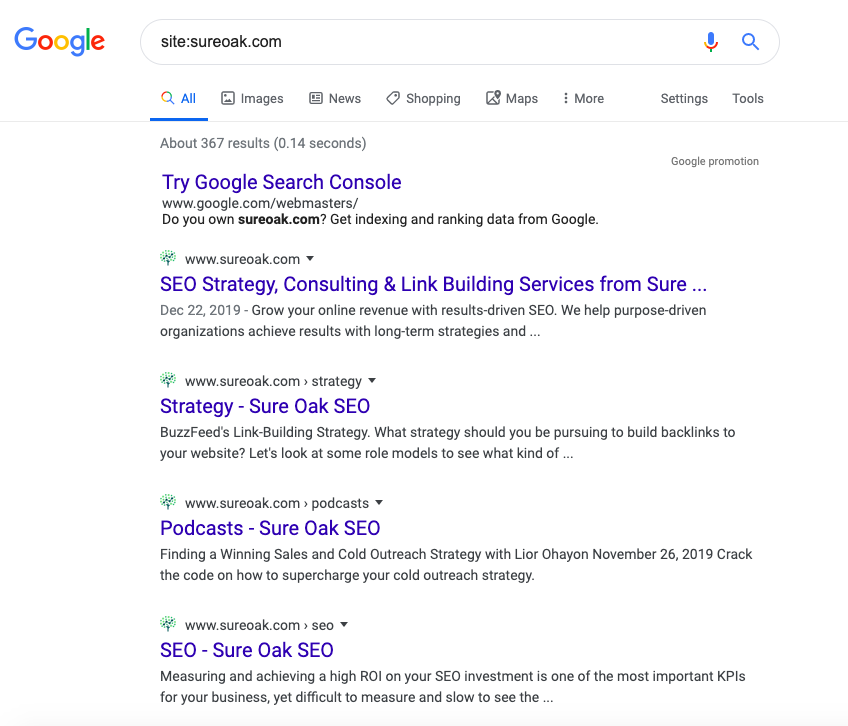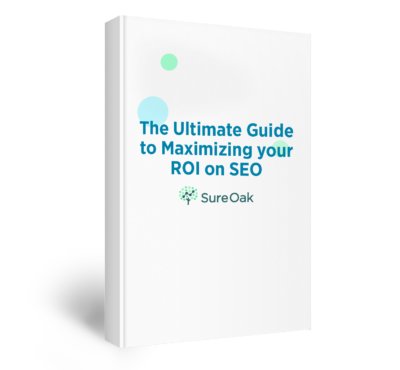Let’s be real: Search Engine Optimization (SEO) can be really confusing.
And if you feel this way, you’re not alone. Research suggests that only 36% of small businesses have an SEO strategy, and it’s easy to see why.
The problem isn’t a lack of information—it’s actually the opposite. There’s too much information out there to make sense of it all.
There are tons of SEO gurus who claim to have the “shortcut” to getting SEO results instantly. Unfortunately, if you follow their advice, you’ll usually end up with the same results as everyone else: peanuts.
Well, it’s time to rip the Band-Aid off. There is no “shortcut,” and there are no “instant results” in the world of SEO.
Good SEO requires hard work and commitment. It demands a solid strategy. There’s no substitute for that.
Despite these obstacles, more business owners than ever are investing in SEO. And that’s because it really works!
Showing up on the first page of Google is the #1 way to drive qualified traffic to your website—without spending piles of cash on advertising, at least.
That’s why I invite you to step off the hamster wheel. 2020 is the year stop spinning; it’s the year to get serious about SEO, and I’m here to help you do that.
When it comes to SEO, you can get 80% of the results with only 20% of the work. You do not have to be a seasoned professional to rank for your target keywords; all you need is a solid strategy and a commitment to investing the time.
If you don’t have time to learn SEO yourself, consider an SEO partner, and making an SEO investment in your marketing budget. The ROI on SEO can be huge over time.
“If you don’t have a strategy that nails the three essential elements of SEO, you’re flying blind.”
-Kim Melillo, CEO of Sure Oak
In this article, I’ll coach you through the three key elements of a winning SEO strategy. This strategy will not only remove the guesswork involved in SEO; it will help you find real results in the search engines.
Ready to get started? Keep reading or watch this short explainer video!
Thinking Like a Robot
In order to understand how to optimize your website, we first need to understand how search engines work.
Google’s top priority is to satisfy the searcher’s needs. For example, if you search for apples and Google returns with pictures of oranges, you’re more likely to switch over to Bing.
And with the internet being as big as it is, Google has enlisted an advanced algorithm to help sift through all of the webpages on the internet, organize them in an index, and deliver the most relevant pages to you.
Unfortunately, nobody is perfect—not even robots. In order to achieve the rankings we’re after, we need to do everything we can to “nudge” the algorithm in the right direction.
We can break this task down into 3 actionable parts:
- Content strategy
- On-site SEO
- Off-site SEO
A Fair Warning
Before we get too far ahead of ourselves, it’s important to remember that Google’s algorithm is very smart, and it’s getting smarter every day.
If you fall too far into the SEO rabbit hole, you’ll start stumbling upon some fishy tactics to speed up the ranking process. And, although they might work now, any and all attempts to “game” the system will sooner or later get caught.
Every day, Google gets better and faster at shutting down spammy sites on the internet. If you utilize black-hat SEO techniques, it’s only a matter of time before everything you’ve built suddenly evaporates.
There’s your warning. If you choose to go down that road, just know that Google will eventually catch up to your bad deeds.
In this guide, we take a more honest approach to SEO. Instead of “hacking” the search engines for our own gain, we focus on building real equity for users on the internet.
Now that’s out of the way, let’s move on to the main event: the game plan.

Content Strategy
When someone performs a web search, they’re most likely looking for content. That’s why we need to get our ducks in a row in this area before we can move forward.
There are a few subcategories that fit in here, and they’re all equally important in getting your site to rank.
Keyword Research
Before we can get in front of our target audience, we have to know exactly what they’re searching for. If you skip this part you risk writing content that nobody is looking for—a big ole’ time-waster.
To begin, we can “poll” the public to see what words people are typing into Google. This process is called keyword research, and there are a couple of ways to go about it.
First, we can use Google’s Instant feature to get some killer keywords for later.
You may have noticed that if you start typing something into Google, the search box will suggest new words to complete your search.

While it’s a nice feature for searchers, it’s an absolute goldmine for people like you and me. By using this feature to our advantage, we can eventually build a long list of keywords that are relevant to your business.
To get started, all you need to do is type a word, a plus sign, and a letter of the alphabet. Google should take it from there, and it’s up to you to find the keywords that matter to you.

Once you find a good keyword, type it into a spreadsheet for later. Then, just repeat the process for each letter of the alphabet.

You can get creative here, too. Try variations of your initial word, and try some different prepositions instead of a letter of the alphabet.
This method is called the Alphabet Soup technique, and it’s been around almost as long as the acronym “SEO.” As rudimentary as it seems, it’s a great way to find some powerful keywords you’ve never even thought of before.
In the beginning, it might take some time to find keywords that you can truly rank for; so make sure to save a big, meaty list of keywords for later.
Content Analysis
Here, we’re going to dig in and take a look at your website through the eyes of Google. This part is especially important if you already have content on your website.
To begin, we’ll go to google and type in this search query:
site:YourDomain.com
When you type this into Google (with your actual domain instead of the placeholder), you’ll see all of your pages that are currently indexed in Google’s search engine.

This is a helpful way to see your website as it appears on Google. When my team at SureOak performs this for one of our new clients, we usually see quite a few areas for improvement.
Quite a bit of nuance goes into finding those areas, so I’ll give you the abbreviated version:
Most of the time, we spot pages that don’t have a clear keyword. One of your pages may be about coffee mugs, but there’s a chance the word “coffee” doesn’t even appear in the search result for that page.
If your pages don’t have clear keywords, they’re probably not being found in the search engines. And because you’ve already written the content, these will turn out to be some of the easiest wins.
From here, we start writing all of our current pages down and pairing them with target keywords from the list we just made. It’s also a good idea to write down what needs to be done to optimize for those keywords, as well as how to improve those pages for readers.
Content Development
Content is king, and there’s no way around that. At this point, we should be developing a long-term editorial plan to sustainably create content your customers want to see.
Once we’ve paired our current pages with keywords, we start going through the “unclaimed” keywords and creating new pages for them. Though this requires writing new content for those pages, this is by far the best way to expand your reach in the search engines.
When we write the content, it’s important to write it from the reader’s perspective in order to create the content they want. If we can serve the user, Google will reward us.
Google uses a specific framework to assess which pages and websites best serve users and are worth ranking. Keep the acronym E-A-T in mind:
- Expertise
- Authority
- Trustworthiness
Since the early days, Google has always made an effort to reward high-quality content. You must take this into consideration when you write new content.
On-Site SEO
With the content strategy, we outlined what needs to be done to keep everything fresh for our users. But now it’s time to focus on the search engines, which is what on-site SEO is all about.
On-Page Optimizations
This is what most people think of when they hear the words “search engine optimization.” They are the somewhat technical, nitty-gritty details on your website that need to be ironed out. This will make it clear to Google what your webpages – as well as your website – is all about.
There are a lot of factors that go into this stage of SEO; but the primary items to keep in mind are your title tags, meta descriptions, and H1 headers.
You might enjoy using our free SEO tools to spot glaring errors in your HTML. It’s super simple: just plug in your domain, hit enter, and let the tool scan your site. From there, you can see what your score is, and you can have a look at the recommendations made by the tool.
Once you get your list of improvements, you’ll need to create some kind of timeline for addressing them. Our SEO Game Plans usually go over the course of a calendar year, but your site may require more or less time to address, depending on the size of your team and their talents.
Technical SEO
Now we’ve arrived at the phrase that strikes fear into the hearts of webmasters: technical SEO. As squeamish as it makes us feel, it’s a necessary evil in the world of search optimization.
When looking at your site, you need to leave no stone unturned. This is another area where our free SEO tool can help you, but you might need to do some more reading to really nail it.
Here, you’ll need to pay close attention to your website’s loading speed (Google’s Pagespeed Insights tool can help with that), as well as your mobile-friendliness (which Google’s Mobile-Friendly test can show you).
The name of the game here is to nurse your site to a point where it’s easy for Google to find, crawl, and index your webpages. Then we can implement technical SEO to remove all obstacles in this area.
Site Architecture & User-Experience
Once you’ve worked out the technical stuff, it’s time to take a look at how your website works overall.
At this stage, you’ll probably want to enlist a friend – preferably one with some coding or design experience. This gives you a fresh pair of eyes that can catch the small details you might have glossed over.
This friend will sit down, navigate through your website, and take honest notes. The main things to look out for are whether or not the pages are organized in a coherent structure and if it’s easy to navigate to those pages.
Also keep an eye out for internal linking, as this will be important later on when you start building links to your site.
Analytics & Search Console
Optimizing your website for search is not a one-and-done operation; it’s a constant relationship with your website, your users, and Google. That’s why every good SEO strategy involves tracking metrics and other data to further improve your website in the future.
Since this is the case, we’ll want to set up a way to track metrics for your website as it progresses. Luckily, Google has two awesome tools that can help you do that.
The first tool is called Google Analytics. This tool tracks your web traffic and a lot of other related information. Once you get that setup and running for a few months, it’s really interesting to poke around the data in there. You might even be surprised by some of it!
Insights derived from Google Search Console will directly pertain to your search traffic. This is your best friend when it comes to SEO. It will show you the exact keywords you’re ranking for, as well as how many people are coming in from those keywords. Google Search Console also has a helpful feature that scans your website for indexability and will point out errors to you.
Off-Site SEO
Because it’s such a time-intensive process, this is the area of SEO where most businesses will start slacking off. I encourage you to pay close attention to this section, though; it’s just as important – if not the most important – in ensuring your SEO success.
If you’ve done everything outlined in this article so far, you’ve spent a lot of time going over your website with a fine-toothed comb. But did you know SEO expands beyond your website, too?
One of the primary ranking factors Google looks at is called PageRank. It was developed way back when the search engine was developed, and although it involves a little bit more nuance now than it did back then, the general idea is pretty much the same.
Although some might try to convince you otherwise, backlinks are the backbone of any search engine optimization strategy – you will need them in order to win in the search engines.
Backlink Analysis
Before we start building new backlinks, we need to take a look at the backlinks you already have.
There are a couple of tools to do this. You can use Ahref’s backlink checker for free, which will show you your top 100 backlinks without having to sign up.

If you have more than 100 backlinks (most websites do), you’ll have to sign up for one of their subscriptions. You can get a free 7-day trial for $7, which is a great deal as long as you cancel the subscription before the 7 days are up.
You can also use Neil Patel’s Ubersuggest for free—all you need to do is sign up. This tool is a great way to get a snapshot look at all of your backlinks.

Whichever tool you use, here are the main numbers you should be paying attention to:
- Referring domains are the number of domains that are linking to your site. This is the number that really affects your rankings the most, as two backlinks from the same domain don’t carry much more value than one.
- Domain authority (or domain score) is a metric that SEO tools generate based on your current backlinks. In simple terms, the higher your domain authority, the easier it will be to rank for a specific keyword. In the same bubble, the higher the domain authority of any new backlinks you receive, the better that link is.
While we’re here, you’ll also want to know what kind of sites are linking to which pages on your site. Once you find this out, you’ll have a better idea of the type of content you should reproduce to get even more backlinks.
It’s also important you analyze each backlink for quality. Low-quality, spammy backlinks actually hurt your website: you’ll want to disavow these using Google’s Disavow Tool in order to avoid a penalty from Google.
Competitor Analysis
Having an idea of what your competition is up to is never a bad idea. And when it comes to link building, this is doubly true. By performing a competitor analysis (a standard procedure across the SEO industry) we can see what inventive ideas competitors have come up with to generate new links.
To do this, we’ll essentially perform a link analysis for each of your top competitors. This is an awesome way to learn what link building strategies will work best, and you’ll also find a lot of new backlink opportunities that you can go after.
You will also come across some link building strategies that don’t work well. These insights are just as valuable to you, as they’ll give you an idea of what you should stay away from.
The key to competitor analysis isn’t to replicate what your competition is doing, but to outperform them in every category. By doing better than your competitors, you’ll begin to pass them in the search engines.
Link Building Strategy
Once you’ve looked at your current backlinks and your competitors’ profiles, the next logical step is to build a strategy to get more backlinks. This approach, paired with the on-site optimizations you’re performing, lays all the foundations you’ll need to rank higher for your targeted keywords.
Link building is tough; it takes a lot of work to get the backlinks that will really help your site do better. That’s why you should start with the low-hanging fruit:
- Local Business Citations are a great way to build authority with Google. These are business profiles that contain your business address, your phone number, and your company name. They appear on big sites like YellowPages, but you should also look out for smaller niche directories. Although they don’t carry as much value as the more difficult backlinks, local business citations will establish you as a legitimate business. They’ll also help Google distinguish what your business is all about.
- Resource pages are meant to help people who are looking for something. Many websites create these pages just to list resources on a specific topic, or list businesses that do a specific thing. If you find one of these pages that you would fit on, all you have to do is reach out to the webmaster and kindly request your addition.
Once you’ve exhausted all these opportunities, you’ll still want to go after some of the harder-hitting backlinks. Your options are:
- Get yourself—or someone on your current team who has the capacity—fully trained up on SEO quickly. If no one is currently knowledgeable in this area, this is probably not for you. It’s likely that you’ll lose valuable time and revenue with this option.
- Hire a new SEO expert to help you in-house. Find the perfect long-term candidate and onboard them, have them assimilate with your team, gain an understanding of the situation, and then implement and act on their solution. This tends to be extremely expensive, and it could take a couple of months before you even get started. Plus, if you determine you want to make a change down the line (when you’ve made the commitment of employment), that has other implications and complexities as well.
- Identify an SEO firm you can partner with for the next year. At Sure Oak, our link experts work to identify the best linking opportunities based on a number of factors, including Domain Authority, Referring Domains, traffic and content quality. With this analysis, you’ll be able to really understand what steps need to be taken to get your site ranking higher.Schedule a free strategy call with us to make progress right now. If it doesn’t work out, you can easily disengage, and it can save you many months that you would otherwise be losing to your competitors.
Regardless of the approach you take, a holistic approach should incorporate different potential optimizations, from the content on your site to the coding behind it. Finally, we can create a solid link building strategy to get you hundreds of high-authority backlinks to start ranking higher.
The Responsify SEO Game Plan: A Case Study
Only a strategy that includes all three of these elements can really be said to be complete. That’s why our team designed the Sure Oak Game Plan. With our strategy, you get the sort of expert attention in all three of these areas that your company needs to prosper and a solid roadmap for how to move up to the coveted spots online.
Of course, it’s easy for any company to say they’re different. After all, who doesn’t think their own brand is super unique and special?
Having worked in SEO for quite a while, I knew most businesses were not able to really take all this on at once. Unless you work in the SaaS industry, you probably don’t even have someone with deep HTML experience on your staff, and link building remains a mystery for many businesses. I started my company with the goal of addressing this problem.
Perhaps the best example of this is what we did with the Responsify team. Responsify is a Brooklyn based inbound marketing company that focuses on storytelling. By engaging with B2B and software brands to improve their branding, they are able to accelerate growth and ensure that more relevant leads convert into customers.
Knowing they needed to increase their Domain Authority and improve their rankings for critical keywords, Responsify called Sure Oak to partner with them and get the job done. We started with a technical audit of their website and extensive keyword research. This guided us toward several different on-site optimizations, most notably changing the site’s keyword density.
With our keyword research in hand, we were able to work with Responsify’s team to identify the best opportunities. Once we had established these, we were able to begin building out links.
The results of these efforts speak for themselves.
Working with Responsify, we were able to generate an 810% increase in referring domains in less than a year and the site’s Domain Authority increased 14 points, from 16 to 30.
But, perhaps most importantly, Responsify saw a 582% increase in monthly traffic over the previous year. To read more about our work with Responsify, check out the case study.
When it comes to SEO, it would be hard to beat the years of experience our team is able to bring to the table. If you’re looking for a permanent partner for your ranking needs, Sure Oak is sure to be a good fit.
If you don’t have the internal team or the bandwidth to take this on yourselves, set up a free SEO consultation with one of our strategists. They will be able to provide details specific to your company, helping you to make an informed decision. If you’d like to know more about Sure Oak, our philosophy, and why we would make a great partner, click here to learn more!




